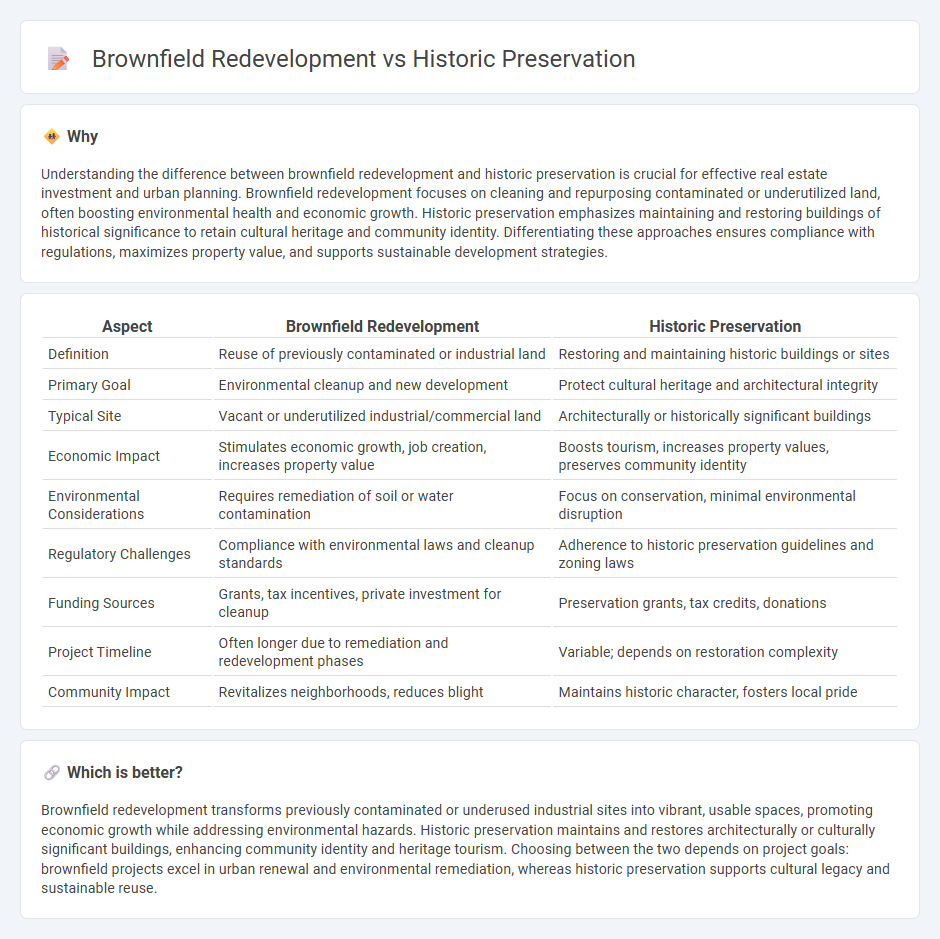
Brownfield redevelopment focuses on transforming contaminated or underutilized properties into productive real estate assets, often revitalizing urban areas and reducing environmental hazards. Historic preservation emphasizes maintaining and restoring architecturally or culturally significant buildings to protect heritage and boost community identity. Explore how these distinct approaches shape real estate development strategies and urban revitalization efforts.
Why it is important
Understanding the difference between brownfield redevelopment and historic preservation is crucial for effective real estate investment and urban planning. Brownfield redevelopment focuses on cleaning and repurposing contaminated or underutilized land, often boosting environmental health and economic growth. Historic preservation emphasizes maintaining and restoring buildings of historical significance to retain cultural heritage and community identity. Differentiating these approaches ensures compliance with regulations, maximizes property value, and supports sustainable development strategies.
Comparison Table
| Aspect | Brownfield Redevelopment | Historic Preservation |
|---|---|---|
| Definition | Reuse of previously contaminated or industrial land | Restoring and maintaining historic buildings or sites |
| Primary Goal | Environmental cleanup and new development | Protect cultural heritage and architectural integrity |
| Typical Site | Vacant or underutilized industrial/commercial land | Architecturally or historically significant buildings |
| Economic Impact | Stimulates economic growth, job creation, increases property value | Boosts tourism, increases property values, preserves community identity |
| Environmental Considerations | Requires remediation of soil or water contamination | Focus on conservation, minimal environmental disruption |
| Regulatory Challenges | Compliance with environmental laws and cleanup standards | Adherence to historic preservation guidelines and zoning laws |
| Funding Sources | Grants, tax incentives, private investment for cleanup | Preservation grants, tax credits, donations |
| Project Timeline | Often longer due to remediation and redevelopment phases | Variable; depends on restoration complexity |
| Community Impact | Revitalizes neighborhoods, reduces blight | Maintains historic character, fosters local pride |
Which is better?
Brownfield redevelopment transforms previously contaminated or underused industrial sites into vibrant, usable spaces, promoting economic growth while addressing environmental hazards. Historic preservation maintains and restores architecturally or culturally significant buildings, enhancing community identity and heritage tourism. Choosing between the two depends on project goals: brownfield projects excel in urban renewal and environmental remediation, whereas historic preservation supports cultural legacy and sustainable reuse.
Connection
Brownfield redevelopment and historic preservation intersect by transforming previously contaminated or underutilized sites into valuable, functional properties while maintaining architectural heritage. Preservation of historic structures within brownfield sites often boosts community revitalization and increases property values by blending cultural significance with modern development. Integrating environmental cleanup with restoration enhances sustainability and supports economic growth in urban real estate markets.
Key Terms
Adaptive Reuse
Adaptive reuse plays a critical role in both historic preservation and brownfield redevelopment by repurposing existing structures to meet modern needs while retaining cultural significance. Historic preservation emphasizes maintaining architectural integrity and heritage values, whereas brownfield redevelopment targets contaminated sites, transforming them into productive assets through environmental remediation. Explore further how adaptive reuse balances sustainability, economic viability, and community revitalization in urban planning.
Environmental Remediation
Historic preservation emphasizes maintaining the architectural integrity and cultural significance of existing structures while integrating environmentally sustainable practices. Brownfield redevelopment targets previously contaminated industrial or commercial sites, prioritizing thorough environmental remediation to eliminate pollutants and prepare the land for safe, new use. Explore how balancing these approaches can maximize urban renewal and sustainability efforts.
Tax Credits
Historic preservation tax credits offer significant financial incentives for rehabilitating historic buildings, often covering 20% of qualified expenses through federal programs, making them highly attractive for conserving architectural heritage. Brownfield redevelopment tax credits, on the other hand, provide benefits aimed at environmental cleanup and redevelopment of contaminated properties, often varying by state and focusing on reducing remediation costs to stimulate economic revitalization. Explore the specific tax credit opportunities available in your area to maximize project feasibility and benefits.
Source and External Links
Historic Preservation - Environmental Review - HUD Exchange - This webpage discusses how HUD supports the rehabilitation of historic buildings and archeological sites, emphasizing compliance with the National Historic Preservation Act for federal projects.
Historic Preservation - Wikipedia - This article provides an overview of historic preservation as an effort to conserve buildings, objects, and landscapes of historical significance, detailing its evolution and legal frameworks.
What is Historic Preservation? - National Park Service - This webpage explains historic preservation as a dialogue with the past, highlighting its role in encouraging private investment in historic building rehabilitation and community revitalization.
 dowidth.com
dowidth.com